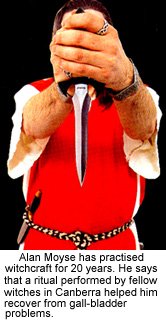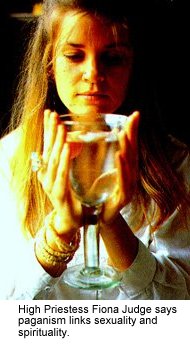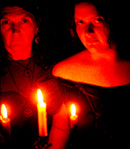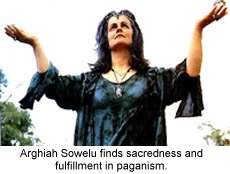Australian Media on Paganism
She Magazine, Dec 1995

The
Witches
Of Suburbia
By Stephanie Osfield
Covens! Cauldrons!
Canberra?
Behind the quiet facade of suburbia, a new wave of witchcraft
is brewing. Casting off their clothes, groups of pagan public
servants are turning to sorcery and magical rituals to weave
spells, reveive spiritual guidance and heighten their supernatural
enegies.
The middle of a Canberra
winter produces air that is crisp enough to eat. Your fingers
and toes turn white, then blue in protest and you can easily
imagine your breath freezing into icy stalactites on your tongue.
Yet angry skies and below-zero temperatures don't prevent some
of the local witches from going "sky- clad" or naked in the
"livery of the goddess".
"Removing clothes is just one way to achieve altered consciousness,"
says 35-yearold witch Leone Moyse. "It's designed to strip away
all the props we hide behind every day."

To ensure that both body and mind are purified, many fledgling
witches don't eat or drink for 24 hours before initiation. "Then
you're stripped naked, with your hands tied behind your back
and sometimes your feet are bound as well," says Leone's husband,
Alan, who has practiced witchcraft for the past 20 years. "You're
brought to the edge of the circle and challenged, with the point
of a sword at your throat. But before being accepted, you must
convince the coven that you're there of your own free will.
One of the witch's most important code of ethics is "Do what
you will but harm none."
Casually dressed in jeans and jumpers, Alan and Leone seem
an unlikely pair of witches. From nine to five, they're engaged
in paper chasing for the Department of Housing and Comcare.
But come full moons, solstices and the odd equinox, they join
a plethora of magic-making public servants who've grown tired
of the misogynistic, guiltridden teachings of conventional religion
and choose instead to shimmy into robes, tunics or pseudo-medieval
garb and new-age jewellery, to worship the earth and weave spells.
Whether it's the physical setting or the latent Aboriginal
energy, the nation's capital is said to have the perfect lay
lines for practising magic. When flooding creeks prevent safe
passage to their secret locations on Canberra's outskirts, the
eight members of Alan and Leone's coven have been known to conduct
rituals in their backyards.

"It's not a case of anything goes. As a witch I practice a
worldwide, nature-based religion which teaches me to take responsibility
for all my actions," says Alan who, this very morning, has been
swapping ideas with American witches on the Internet.
Before our arrival, I'd imagined a front pathway lined with
goat skulls or at least bathroom tiles shaped like pentagons.
But in their modest suburban home, the evidence of witchcraft
is more subtle: a sideboard covered with crystals and dragons;
a bookshelf boasting titles such as The Encyclopedia of Demonology;
a black-and-white pentagram wall-hanging and an Arthurian-looking
sword tucked away in a side room.
"Practicing witchcraft enhances my concentration and visualisation
skills, particularly at work," says Leone. "Collectively, I
see it give others direction by providing inner peace and the
insight to understanding their fellow man. It's not just hocus
pocus - magic has practical applications."
"A few years ago I had my gall bladder removed and when things
went wrong, the coven got together and successfully worked a
ritual to help me get better," agrees Alan, whose English lineage
has been traced to a 17th century Kentish relative burnt at
the stake. "But if I've got a headache, I don't mutter incantations
- I take an aspirin. For trivialities, why bother the gods?"
Why indeed, when they include forces such as Shiva, the Hindu
god of cosmic destruction, or Hecate, a three-headed Hellenic
sorceress of the underworld. In the Stevie Nicks song, Rhiannon,
the witch Rhiannon was portrayed as a romantic cliche, but in
Celtic folklore she's accused of devouring her own son and smearing
her face with the blood of puppies.

Leone questions the commonsense and wisdom of some pagans who,
in sheer ignorance, choose ambivalent deities such as Rhiannon
as namesakes. "Taking a secret witch name is not the same as
calling your pet Sooty," she points out. "All magic is like
a loaded gun. When you open a gateway to invite spirits into
your circle, it's like lighting a candle and waiting for the
moths to come. If you don't close the gateway properly, like
psychic parasites, some of the moths stay and strange things
start to happen."
Witches don't have a formal
church, so when they meet - accordrng to the cycle of the moon
- they bless their space by invoking energy from the north,
east, south and west and acknowledging the four elements: earth,
air, fire and water.
"This is an athame, which represents the dual edge of truth,"
says Margaret Turner, as she pulls a small dagger from a b lt
around her waist. "As a witch, it's one of my most important
tools. During rituals I might move it through the air to cast
a formal circle."
 |
Into
the melting pot
Most pagans and
witches draw from a range of belief systems that include:
WICCA The nature-based religion of Europe and (in particular)
England. Witches (pagans who follow Wicca), can be male or
female.
PAGANISM A belief structure that worships a pantheon
of gods and goddesses and links the cycle of the seasons to
spiritual practice. It operates outside conventional faiths
such as Judaism and Christianity.
SHAMANISM Magic ritual and practices in the American-Indian
tradtion.
VOUDOUN A native Christian religion with heavy pagan
overtones, practised on Haiti and other Caribbean islands.
REIKI A new kind of new-age faith healing.
Festivals of the
witch
In Australia, eight pagan festivals honour the seasons and
celebrate an aspect of the life cycles of the goddess and
the horned god, who dies and is reborn each year.
SAMHAIN (May1) Seen as the day of the year dies and
the earth opens up so that spirits can walk the land. The
goddess goes to the underworld where she learns the secrets
of witchcraft. She mates with the god and conceives a child
who will be born at Yule.
WINTER SOLSTICE - YULE (June 20 to 23) Worships the
birth of the sun-god, the child of the reigning moon-goddess.
IMBOLC - CANDELMAS (August 2) Marks the quickening
of the year. With white flowers and a feast, the goddess is
celebrated.
SPRING EQUINOX - EASTER (Sept 20 to 23) Celebrates
the return of the god who died at Mabon.
BELTANE ((Nov 1) By the mating of men and women in
the fields, the earth is made more fertile through a land/spirit
marriage.
SUMMER SOLSTICE - LITHA (Dec 20 to 23) Celebrates the
god and goddess at the peak of their power.
LAMMAS (Feb 1) The child of the god is seen in two
aspects - as the horned god or king and his son, the younger
god. The two engage in battle and the king is wounded.
AUTUMN EQUINOX - MABON (March 20 to 23) The king and
his male child die and go to the underworld; the goddess enters
cronehood.
|
In their home in Liverpool, in Sydney's south-west, Margaret,
a State Rail phone technician, and her partner, Ken, have set
up an altar to face the east. It is covered in candles which
are lit daily in honour of a god and goddess, a chalice, a pine
cone, an assortment of crystals and shells and a stone pentagram,
where a piece of jewellery or food might be placed for consecration.
Margaret and Ken belong to a Sydney coven called Eldergrove.
At witch meets, Some of the spells they use are as old as Stonehenge.
Others are more modern and free-form. In the centre of the circle,
a castiron cooking pot doubles as a cauldron and might be filled
with water to form a reflective surface for prophetic seeing.
Or it might be turned placed over a fire, to magically charge
a herbal liquid or powder, which is then used to bathe a sick
person's forehead or wrists. There are no bloodcurdling ingredients
like eye of newt or bat's blood. In fact, in ye olde days, these
were just code words for herbs, so that secret medicinal recipes
could be handed down from one generation of healing women to
the next.
Few modern witches dabble in love potions or curses. They're
more likely to cast a spell to help a coven member get a new
job or house or open up to the right partner. "We might do healing
work or candle magic, where you charge the flame with magic
through your intention and a protective oil such as verbena,"
says Margaret's teenage daughter, 15-year-old Naomi, who plans
one day to get a blue woad tattoo (1ust like Mel Gibson in Braveheart).
Once the ceremonial formalities are over, the group closes circle,
feasts on cakes and ale and often parties late into the night.
"That doesn't mean we leap over the fire and conduct orgies,"
says Margaret, holding up a trident-like staff which represents
one of her witch names, ghost-gum. "But if I want to throw my
clothes off during a ritual, I've been known to do so without
feeling embarrassed. Wicca [modern witchcraft] is a fertility
religion, so my coven celebrates the dance of life between the
male and female."
Formerly a practicing Catholic, Margaret became interested
in witchcraft four years ago, after her eldest daughter brought
home a book written by a Salem witch. Now Wicca dominates her
social calendar. "In Christianity, the earth is characterised
as hell, but in paganism it's seen as the goddess. That's why
I call witchcraft the spiritual side of environmentalism. At
home I recycle, compost, use biodegradable products and bucket
water from my washing machine for re-use. To be a good witch
involves a great deal of self- development and respect for nature."
For the layperson, this
is known as white witch-craft. But, according to Australia's
5,000 or so practising pagans, there's no such thing as white
or black magic. "I think of darkness as being hidden energy
or crone energy, but it's not black in the sense of evil," says
Fiona Judge, who is a co-founding member of the Australian branch
of the Church Of All Worlds (CAW), an international pagan organisation.
With her flaxen hair and aquamarine eyes, Fiona, 31, has all
the synergy of a high priestess, which is the level to which
she has been ordained by her pagan church. Had she lived in
1595, not 1995, she might have been accused of the "obscene
kiss" (kissing the devil's backside) and her fluffy white cat,
Pavlova, would have been called her evil "familiar". But at
the Department of Education, Employment and Training in Canberra,
where Fiona works, she doesn't hide her beliefs.
In the 15th to 17th centuries an estimated nine million women
who were accused of witchcraft died after being stripped, flogged,
pressed under stones, burned at the stake, drowned or subjected
to having their fingers and toes crushed in a vice. Those who
practise modern magic fare better, but are still accused of
debauchery or suffer prejudice from sceptical employers or neighbours.
"I'm often called a devil-worshipper, which I think is amusing
since I don't believe in the Christian ideology of God versus
the devil," Fiona says, nibbling on a vegetarian roll as she
runs late for an appointment to get her legs waxed. "The fact
that we have become so technologically advanced but haven't
concurrently worked on developing our spirituality is, in my
view, one of the biggest problems with our world."
Around 312AD, the Romans decided the fastest road to conversion
was to superimpose Christian ceremonies on pagan festival dates
and incorporate many of a pagan tribe's spiritual beliefs into
the Christian religion. Some pagan practices, however, were
considered far too liberated and were stamped out.
On the first of May, pagans once lit bonfires and men and women
who lusted after each other could consummate their attraction
in the hills and fields, then part company with no strings attached.
In the '90s, some pagans still celebrate this fertility festival
of the Beltane fires by engaging in free love and dancing around
the maypole - the wooden rod representing the male phallus and
the head-piece where the red (for menstrual blood) and white
(for semen) ribbons attach, symbolising the yoni or vagina.
"For me, Beltane is about the marriage between land and spirit,
male and female, god and goddess," says Fiona. "We raise energy
through ritualised dance, song and music, empowering the May
queen and king (who are the vessels of the community), with
our hopes and desire for the upcoming year. This is where paganism
often becomes threatening to people, because it doesn't renounce
or separate sexuality and spirituality."
In Australia, spring begins in October when a maypole seems
palpably out of place. So come the change of season, Fiona gets
into creative mode to devise a regional Beltane festival. "I
might design a ritual around the mating patterns of the magpie,
with ritualists depicting magpies through body paint, feathers,
movement and sound," she says. "They would be on tall stilts,
from which they would take turns dive- bombing onto the unsuspecting
people dancing below. The ritual might also incorporate people
in trance, drumming, dancing and chanting."
Two years ago, when Fiona pierced her nose, she put herself
in such a trance. "My eyes were open and I was fully aware of
what was going on, but the pain didn't affect me and there was
no bleeding," she explains. Controlling pain through sheer willpower
is a common shamanic practice.
Among modern witches and
pagans, shamanism, Voudoun and tribal lore have overtaken crystals
and reiki healing as the new buz concepts. "I embrace aspects
of Aboriginal and American Indian culture," says Arghiah Sowelu,
42, who became involved in magic when a friend suggested they
share a "cup of healing water".

At her bush home Arghiah, who calls herself a high priestess,
holds occasional healing groups for women. At witch and pagan
gatherings, she follows the Celtic tradition of the bard, who
tells self-devised stories in speech and song. "Most of us become
disconnected from our innocent spirit because of what society
and family impose on us," she iays. "We learn to accept pain
into our lives. But since embracing paganism, I've realised
I'm not the product of my experiences. I spent many years feeling
as though I hadn't found my true purpose. Now I realise it was
the sacredness of ritual I'd always craved. There's ritual involved
in speaking, listening, touching, even making a cup of tea.
But in modern society, we've minimised sacredness so that we
have no Dreaming."
In every culture, tribal
beliefs have always embraced the union between nature and nurture.
The Aztecs worshipped the Sun-God, Koori tribes revered their
animal totems and the Nordic tribes believed in the power of
rune magic. The tradition of reading the runes is similar to
prophesying with tarot cards. "Runes can be catalysts or you
can meditate on them, sticking your hand in the bag and pulling
them out to get a daily reading for guidance," says Chandra,
a 28-year-old Can- berra hairdresser who carved her 26 runes
out of the wood from a friend's apricot tree.

Chandra is a former member of CAW, and is now studying religion
at the Australian National University in Canberra. "Most orthodox
religions are very patriar- chal. But with witchcraft, women
are not marginalised," she says. "That's why I think magic and
paganism are regaining popularity. By practicing ancient traditions,
we're recalling times when women were revered as village wise
women and healers. We're reclaiming our feminine power."
The Pagan Information Service (0055 20293) has information
on pagan events and literature.
She Magazine, December, 1995
|